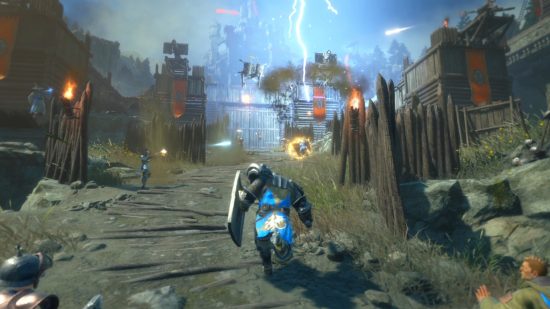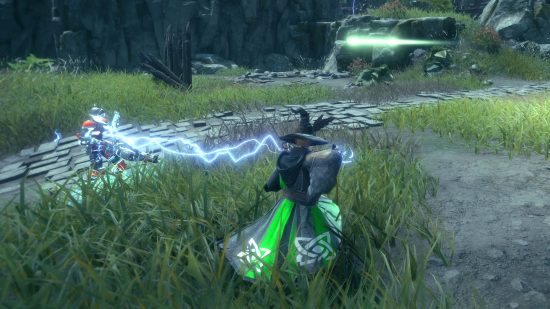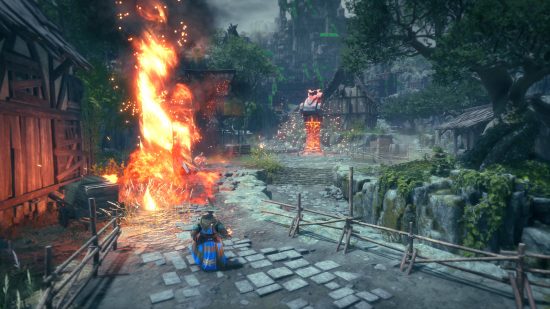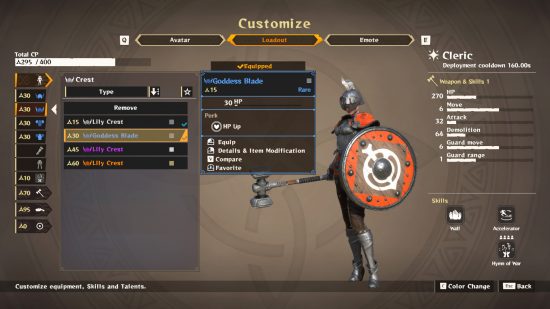It’s tiring work being part of the Castle Guard Squad. Noobhunter69 has died for the sixth time while trying to fix up a ballista, while JohnCenaFan hasn’t been seen since the beginning of the game. I on the other hand have just been goomba stomped by a hulking, bogey-green-haired Centurion who’s now making a beeline for our castle’s core – the destruction of which is the main win condition in a Warlander match. Fortunately, while we’re having a bit of a ‘mare, the other four squads which constitute our army have been hard at work making ground, and finally crack the enemy’s core. The battle is over, we are victorious.
At its core, Warlander is a Medieval hack ‘n’ slash much in the same vein as the Chivalry series, with MOBA elements thrown in for good measure. However, unlike the more historically accurate titles out there, there’s also magic involved. Oh, and robots – though I must admit that I was disappointed we didn’t get to see them during the preview session for Toylogic’s latest offering we were recently invited to. From the short time spent with the game, my initial impression of Warlander is that, while it is really good fun, it is at risk from being weighed down by its numerous systems.
Warlander’s basic gameplay loop – at least for the 40-player, ‘2 Team Duel’ mode we played during the session – is fairly simple: spawn in with your team, fight through to the enemy base, and destroy its core. Throughout the map – itself a lush, mountainous area with three ‘lanes’ in a similar vein to the best MOBA games like Dota 2 and League of Legends – are capturable objectives that will make the battle easier. These include catapults that can rip through defences, and towers in forward locations that will let you spawn closer to your enemy’s base.
This isn’t a straight up brawl, either, with your 20-strong team getting split into five different squads before the match kicks off. Alongside the aforementioned Castle Guard Squad, which is tasked to guard the castle through building and manning base defences, you have three Assault Squads, which head out and cleave down enemies on the field as they make their way towards the enemy base, and a Special Ops Squad that has the sole purpose of capturing those tide-turning neutral objectives.
In theory, these structures should ensure everyone knows what they should be focusing on during a match, though our lobbies quickly descended into chaos – defending the castle gets boring when the rest of your team is marching on the enemy’s gates, after all. With that said, in a better-coordinated game, these squad divisions will pay dividends, as players will be primarily communicating with their crack team of fighters, instead of one homogenous mass.
Of course, there has to be a chain of command, and at the beginning of each game one player assumes the role of Commander. As Commander, a number of tools become available to you, including the ability to pull up an overview of the entire field, and mette out commands (instructions) to your legion of minions (other players). Despite my best efforts I ended up being less Genghis Khan and more Genghis Khan’t when I assumed the role for my first match, and my army was brutally blitzed by the enemy.
While robots weren’t quite on the menu, throughout these matches we did get to experience Warlander’s default classes – Cleric, Mage, and Warrior. The booms and busts of each class are well-defined, and each comes with two different default weapon/ability loadouts that could be quickly switched between at a moment’s notice. As a Cleric, I wasn’t the most sturdy of characters, and was best-suited to empowering front-liners with a variety of buffs while providing covering fire with my crossbow. Should an ally fall, I could accelerate myself forward and revive them, hammer-out should I need to protect myself up close.
While assuming the role of a Warrior, I could use my skills to either close the gap between myself and a target, before unleashing a devastating blow, or act as a one-man phalanx by creating a barrier with my shield to protect my teammates – this was especially useful when my cleric was trying to bring someone back into the fray.
Judging from its popularity on the field, for most the favourite class – myself included – was the Mage. With the ability to do everything from calling down bolts of lightning, to unleashing a fiery barrage upon a cluster of combatants, the Mage rewards good timing and accuracy. Although the basic magical attacks it quickly dishes out aren’t the most potent, they can melt through enemies if your aim is on point.

The feel of Warlander’s combat across all three classes is satisfyingly weighty, with each hit – particularly those from melee weapons – providing a satisfying ‘thock’. Of course, few things could compete with the almighty crack of a lightning bolt crashing down on a group of enemies; Mage is fun, but the other classes have their moments to shine.
When out on the field, despite skirmishes at times becoming chaotic as wave after wave of players clashed, I rarely found myself struggling to visually process what was happening in front of me, even when the Mage’s Fog spell obscured vision of pockets of space. Ability indicators, particularly for area of effect spells and auras, are crystal clear, and hits landed are affirmed by clearly-legible damage counters.
Of course, while running around as a more spritely Gandalf is fun, there are times when you need to switch things up to balance out your team’s combat triangle. Fortunately, you don’t have to stick to one class per game, though this is where things start to get a little complicated in places. In Warlander you can have up to five characters in a pre-arranged ‘deck’ that you can spawn in as during the match (think along the lines of rifling through different types of Stormtrooper in the Star Wars Battlefront games).
However, your top level units – which are modified versions of the basic classes created through ascribing different titles to them, unlocking their potential – can only be accessed when enough Valor – which is earned by defeating enemies and taking objectives – has been attained. But this isn’t the only time Valor comes into play, as a separate form of it exists as a currency outside the arena, and can be used to unlock more titles.
While you’re sorting out your deck in Warlander’s main menu, you can do more than just boost the innate power of your characters through titles. Here you can swap out the abilities in your loadout, or throw in more powerful versions of existing spells, weapons, and armor – the latter two of which dramatically change your appearance – should your unit have the required CP budget for it (higher-quality units have a greater CP budget). You can also activate certain traits at a CP cost, providing bonus stats.
I could have made some major tweaks to my battle capabilities between matches, though I was hesitant to do so due to the sheer number of possible gear combinations, as well as a lack of awareness of what is optimal for each class. Indeed, in order to master the intricacies of Warlander’s classes, players will need to properly get their theorycrafting hat on – something I definitely didn’t have time to do.
Warlander also boasts the capability for customising how your units look, granting you access to a decent array of options for doing so. Here you can switch up everything from your face, to the color of your armor, and even the emblem you proudly adorn on your gear. It’s no Elden Ring, but it will get you looking battle-ready. And with Warlander’s fairly pedestrian base designs for its characters, you’re going to want to add all the aesthetic spice to your units that you can, through both equipping stronger gear and making it pretty.
As you can probably tell, there’s quite a lot going on in Warlander, though to be perfectly honest you don’t need to engage with all of its systems to enjoy a rich, hack ‘n’ slashing, castle-crashing experience – at least I didn’t throughout the preview. Whether or not that renders some of these systems – particularly when it comes to levelling and switching up gear – superfluous remains to be seen, though they cannot be fully-evaluated from just a couple of hours of play.
Having now entered open beta, we’re eager to see how those who slap on their armour and take up their arms get on with Warlander. Though I only experienced it fleetingly, I am keen to return for more.


